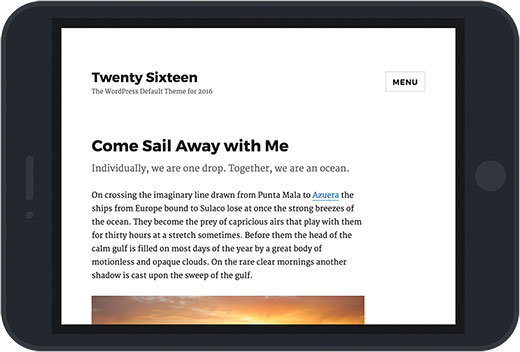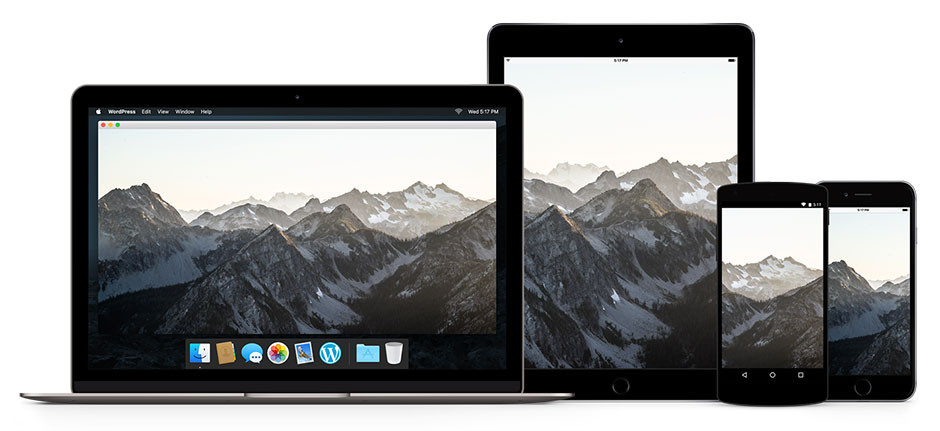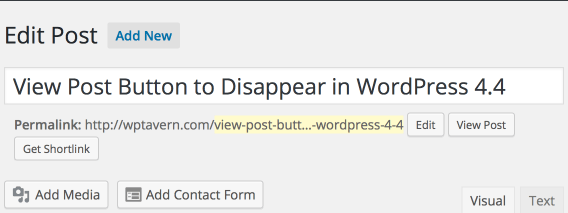WordPress 4.4, “Clifford”, has been released. Version 4.4 includes the new Twenty Sixteen default theme, the ability to embed posts anywhere and responsive images straight out of the box, as well as the infrastructure for the WordPress REST API, taxonomy and comment improvements, and much more.
New default theme Twenty Sixteen
A modern take on a classic blog design. Twenty Sixteen works perfectly for blogs. A fluid grid design, flexible header, fun colour schemes, and more. The Twenty Sixteen theme is very minimal and relies primarily on typography.

Responsive images
As devices and their screens will differ in size greatly nowadays, designers must work with a large variety of images sizes as well. Serving a full screen desktop size to you mobile phone means slower page loading times. Width version 4.4 WordPress now supports responsive images. Images added via WordPress will use the socalled srcset attribute. This helps to regulate image sizes based on what each screen can properly display.

Project lead Joe McGill outlined how responsive images work, from a technical perspective.
Embed your WordPress content
Embedding a YouTube video or a tweet via the so called oEmbed features (meaning simply adding the link was all you needed to do) was already a breeze. In WordPress 4.4 you can now easily embed content anywhere on your site just by grabbing the URL of a post and pasting it into the content editor. A preview of the post that you embed will appear on your page, something like this:
If for some reason, you feel that you don’t want to use this feature, then you can disable it by installing the disable embeds plugin.
Even more embed providers
In addition to post embeds, WordPress 4.4 also adds support for five new oEmbed providers: Cloudup, Reddit Comments, ReverbNation, Speaker Deck, and VideoPress.
The concept behind oEmbed is to allow for easy embedding of content based on a single URL. This means you can copy/paste a YouTube video directly into a post and WordPress will auto-generate the required embed code.
Removes the View Post and Get Shortlink Buttons From the Post Editor
A small tweak in the back-end. In WordPress 4.4, the View Post button in the post editor is disappearing in favour of a clickable permalink.
Here are two screenshots of the post editor. The first is WordPress 4.3 and the second is WordPress 4.4. Clicking the permalink allows you to preview the post in its current state. Notice the slug part of the URL is in bold. You need to click the Edit button to edit the permalink.


Under the Hood
REST API infrastructure – Infrastructure for the REST API has been integrated into core. The REST API serves to provide developers with a path forward for building and extending RESTful APIs on top of WordPress. With this infrastructure web developers are able to build their own APIs for their themes, plugins, even mobile or desktop apps.
Term meta – Terms now support metadata, just like posts.
Comment query improvements – Comment queries now have cache handling to improve performance. New arguments in WP_Comment_Query make crafting robust comment queries simpler.
Term, comment, and network objects – New WP_Term, WP_Comment, and WP_Network objects make interacting with terms, comments, and networks more predictable and intuitive in code.
Changes to WP_Title – Another code-based change is the move away from WordPress’ well-known wp_title() method. The initial plan was to completely deprecate wp_title(), but this would cause a lot of confusion. The WP team has instead chosen to maintain support while encouraging devs to move onto the newer title tag feature.
WP_Network for Multisites – There are many under the hood improvements for multisite networks in WordPress 4.4. Most important one is the introduction of WP_Network class. It provides a better way to handle multisites
Single Post Template File – In this version, WordPress included a new template file on theme hierarchy to be used as a single post or custom post type. This feature is useful when you are targeting a specific post, to give ‘special’ styles to that page so it will look different from other pages.
Improved Comments – WordPress has made rearrangements on the comment form, where the comment field is displayed first, then the name and email fields below. This improvement was the answer to the issue that the comment behaviour is different for logged in and logged out user.
